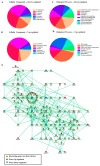The Modulation of Septic Shock: A Proteomic Approach
- PMID: 39408970
- PMCID: PMC11476436
- DOI: 10.3390/ijms251910641
The Modulation of Septic Shock: A Proteomic Approach
Abstract
Sepsis poses a significant challenge due its lethality, involving multiple organ dysfunction and impaired immune responses. Among several factors affecting sepsis, monocytes play a crucial role; however, their phenotype, proteomic profile, and function in septic shock remain unclear. Our aim was to fully characterize the subpopulations and proteomic profiles of monocytes seen in septic shock cases and discuss their possible impact on the disease. Peripheral blood monocyte subpopulations were phenotype based on CD14/CD16 expression by flow cytometry, and proteins were extracted from the monocytes of individuals with septic shock and healthy controls to identify changes in the global protein expression in these cells. Analysis using 2D-nanoUPLC-UDMSE identified 67 differentially expressed proteins in shock patients compared to controls, in which 44 were upregulated and 23 downregulated. These proteins are involved in monocyte reprogramming, immune dysfunction, severe hypotension, hypo-responsiveness to vasoconstrictors, vasodilation, endothelial dysfunction, vascular injury, and blood clotting, elucidating the disease severity and therapeutic challenges of septic shock. This study identified critical biological targets in monocytes that could serve as potential biomarkers for the diagnosis, prognosis, and treatment of septic shock, providing new insights into the pathophysiology of the disease.
Keywords: blood clotting; hypotension; monocytes; secreted proteins; systemic dysfunction; vascular injury.
Conflict of interest statement
The authors declare no conflicts of interest. The funders had no role in the design of the study; in the collection, analyses, or interpretation of data; in the writing of the manuscript; or in the decision to publish the results.
Figures

References
-
- Evans L., Rhodes A., Alhazzani W., Antonelli M., Coopersmith C.M., French C., Machado F.R., Mcintyre L., Ostermann M., Prescott H.C., et al. Surviving Sepsis Campaign: International Guidelines for Management of Sepsis and Septic Shock 2021. Intensiv. Care Med. 2021;47:1181–1247. doi: 10.1007/s00134-021-06506-y. - DOI - PMC - PubMed
-
- Singer M., Deutschman C.S., Seymour C.W., Shankar-Hari M., Annane D., Bauer M., Bellomo R., Bernard G.R., Chiche J.-D., Coopersmith C.M., et al. The Third International Consensus Definitions for Sepsis and Septic Shock (Sepsis-3) JAMA. 2016;315:801–810. doi: 10.1001/jama.2016.0287. - DOI - PMC - PubMed
MeSH terms
Substances
Grants and funding
LinkOut - more resources
Full Text Sources
Research Materials

